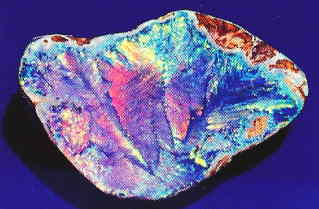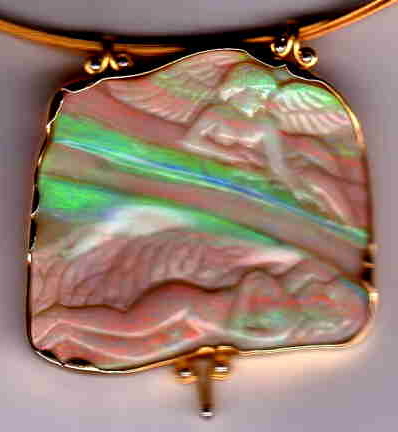Scene Stones, Fun Stones & Cameos

Pattern is undoubtedly what makes Opal such an interesting and most dazzling gemstone.
Stones within which images can be seen are very rare, they are well sought after by collectors worldwide.
Below are a collection of natural solid Opals all have been simply cut and polished without any engraving performed by the lapidary.
 |
 |
 |
 |
 |
 |
 |
 |
 |
| 1.‘Picasso’s Man’
4. ‘Hercules’ 7. ‘R’ |
2. ‘Seaside Panorama’
5. ‘Prawn’ 8. ‘Fern’ pattern |
3. ‘El Gato’
6. ‘Rose’ 9. Madonna & Baby Jesus |
Sometimes the scene or picture is somewhat subjective perhaps resembling modern art, but other times its clearly a cat!
While every Opal has a unique pattern, there are seven categories of patterns that all Opals fit within: Pinfire, Flash, Broad Flash, Rolling Flash, Harlequin, Rare Patterns and Picture Stones. Over 90% of stones have Flash and Broad Flash patterns.
Rare Patterns: Highly collectible in Opal, they only seldom appear and even experts will see very few examples throughout a career in the industry. These include the phenomena of Chatoyancy and Asterism, that is Catseyes and Star Opal, an organically derived ‘Fern’ pattern (8) is another. Often given interesting names which may also vary widely, like ‘Chinese Writing’ or the famed ‘Harlequin’ – a rare pattern indeed! Carefully defined, Harlequin Opal has square or angular patches that can be seen at arms length. Floral and Flagstone patterns are often mistaken for Harlequin yet they are not nearly as rare. An expert can expect to see one or two in their lifetime at best.
Picture Stones: Opals which create a picture with their pattern, sometimes in conjunction with inclusions, that reminds us of a specific object. Whereas rare patterns may be repeated periodically, picture stones are more varied and they are given names which reflect this.




‘Hercules’ a matrix picture stone found at Opalton in discarded mullock heaps on the fossicking reserve by Colin Duff c.1991. Pictured next to several possible likenesses, Hercules wearing the lions head, Freud’s thinking man, and a Spanish Conquistador.
Fun Stones: Low to medium grade Opals of considerable size, usually varieties of Boulder Opal; Yowah nuts, matrix, splits, slabbed or sectioned sets and specimens. Potch, ironstone and scene-like inclusions, which the lapidary would otherwise remove when cutting a gemstone, are retained in the face of the polished article. From such stones often more subjective or imaginative pictures can be interpreted and each person may see different things within them.
 |
 |
|
 |
 |
Structure Lines: Lines in an Opal where the internal structure of the Opal, the size and/or alignment of the silica spheres, has changed. Not cracks. These often provide the basis for unique designs or patterns as seen in picture stones. They also provide the outlines for carvers to follow on from with their craft.
Cameos: Carved out of gem materials with integral layers or banding, such as banded agate, shell or Opal of every variety, preferably where different layers have contrasting colours.
Stone cameos of great artistry were made in ancient Greece as far back as the 6th century BC. This carving technique features a raised (positive) relief image and as opposed to the ‘intaglio’ method which has a negative relief image. Both technologies were also used to adorn the world’s first coinage issued around that time. Cameos were populary worn as jewelry by the Romans and a few rare Opal cameos are attributable to the period. Cameos have since enjoyed periodic revivals, notably in the early Renaissance and during Napoleon’s reign. Queen Victoria was a major proponent of the cameo trend to the extent that they would become mass produced by the second half of the 19th century.
 |
 |
 |
Hand-worked portrait cameos are extremely challenging for a gemstone carver to execute. Very few crasftspeople possess the combination of skill, highly developed artistic ability, and years of experience needed to create life-like portraits. The world centers for fine cameo carving are Torre del Greco in Italy and Idar Oberstein in Germany where the majority of fine opaline examples were made.
Opal is a relative newcomer to the carver’s stock of materials. German carver Wilhelm Schmidt (1845-1938), who set up in England to meet demand for cameos from top London jewellers (including revivalists Brogden, Castellani and Giuliano), documented that he was the first to carve Opal into cameos in 1874. In a letter to A. Booth he wrote that he invented a process of cutting Opal cameos in such a way as to utilize the matrix of the rough Opal for the ground colour and emphatically insisted that no antique or fifteenth century Opal cameos existed. Schmidt carved his cameos from the newly discovered Boulder Opal variety found in Queensland Australia in the early 1870’s. Schmidt’s Opal cameos were exhibited in the 1878 Paris Exhibition by John Brogden and received a gold medal. They were acclaimed by the Paris DailyTelegraph in a June 12, 1878, news story about the exhibition:
Mr Brogden shows a neck ornament which in its nature is unique. The gems in this beautifully designed piece of decoration are camei, each being cut from an opal or the matrix of an Opal. Now, to appreciate the delicacy of such a carving, it must be remembered that the iridescence of this curious stone is due to the minute fractures by which its entire substance is traversed, just as though it had been shivered by some natural shock. As may well be imagined, the splintered formation of the Opal renders it an exceedingly impracticable stone to cut; and though here and there a carved or engraved Opal may be met with, this kind of workmanship is so rare that a cameo necklace must be accounted a wonder of wonders in the jeweller’s art.
Nowadays, the vast majority of subjects (other than commissioned portraits) are not carved by hand, the traditional themes of classical scenes from mythology or a standard image of a young lady, are more likely to be made with the aid of an ultrasonic mill or carving machine. Multiple copies of a master design can be produced relatively quickly, by pressing a master die onto the stone blank. The result is a cameo that has a satin surface texture described as “freshly fallen snow”, by gemmologist and author Anna Miller. This texture and the lack of any undercutting are used by appraisers as evidence to prove that a cameo is machine-made.
Assembled cameos, made by setting a carved Opal relief onto a backing of ironstone are mass produced in Hong Kong, just like doublets they can be readily identified.
Sources & Image Credits:
1-3. ‘Picasso’s Man’ & ‘Seaside Panorama’ set by Christopher Green & ‘El Gato’: set by Les Cichonski all for the bolda collection
4. Colin Duff – ‘Hercules’
5. ‘Prawn’ boulder Opal photo by Len Cram
6. Jerry Doktor – ‘The Rose’
7. ‘R’ Rocky Carbone Collection rocciopals.com, photo taken by opalhut.com.au
8. ‘Fern’ pattern, Opal Identification & Value, Paul Downing, 2001.
9. ‘Madonna & Baby Jesus'(pictured:77.64cts) and sister Boulder Opal split ‘The Blessing’ (130cts) both in the collection of Opaline.
10. Ran Opal – Traditional Japanese art work on Boulder Fun Stones; bejewel.co.jp/en/
11. bolda Aquatica range
12. bolda Luli range
13. ‘Peacock’ jewel created by John Iskenderian, carving by Opaline, photo by Stephen Aracic
14. Opal Cameo carved in Idar Oberstein on the cover of Cameos Old & New, 3rd Ed., Anna M. Miller, 2003. (William Schmidt & John Brogden)
15. Carved Opal faces set in a jet collier by Charlotte de Sylas.
16. Natural Boulder Opal Cameo c.1900
17. THE ENGRAVED GEMS OF CLASSICAL TIMES, John Henry Middleton. 1891.